Zhaoqing Li
Automated Heterogeneous Network learning with Non-Recursive Message Passing
Jan 10, 2025Abstract:Heterogeneous information networks (HINs) can be used to model various real-world systems. As HINs consist of multiple types of nodes, edges, and node features, it is nontrivial to directly apply graph neural network (GNN) techniques in heterogeneous cases. There are two remaining major challenges. First, homogeneous message passing in a recursive manner neglects the distinct types of nodes and edges in different hops, leading to unnecessary information mixing. This often results in the incorporation of ``noise'' from uncorrelated intermediate neighbors, thereby degrading performance. Second, feature learning should be handled differently for different types, which is challenging especially when the type sizes are large. To bridge this gap, we develop a novel framework - AutoGNR, to directly utilize and automatically extract effective heterogeneous information. Instead of recursive homogeneous message passing, we introduce a non-recursive message passing mechanism for GNN to mitigate noise from uncorrelated node types in HINs. Furthermore, under the non-recursive framework, we manage to efficiently perform neural architecture search for an optimal GNN structure in a differentiable way, which can automatically define the heterogeneous paths for aggregation. Our tailored search space encompasses more effective candidates while maintaining a tractable size. Experiments show that AutoGNR consistently outperforms state-of-the-art methods on both normal and large scale real-world HIN datasets.
Phone-purity Guided Discrete Tokens for Dysarthric Speech Recognition
Jan 08, 2025



Abstract:Discrete tokens extracted provide efficient and domain adaptable speech features. Their application to disordered speech that exhibits articulation imprecision and large mismatch against normal voice remains unexplored. To improve their phonetic discrimination that is weakened during unsupervised K-means or vector quantization of continuous features, this paper proposes novel phone-purity guided (PPG) discrete tokens for dysarthric speech recognition. Phonetic label supervision is used to regularize maximum likelihood and reconstruction error costs used in standard K-means and VAE-VQ based discrete token extraction. Experiments conducted on the UASpeech corpus suggest that the proposed PPG discrete token features extracted from HuBERT consistently outperform hybrid TDNN and End-to-End (E2E) Conformer systems using non-PPG based K-means or VAE-VQ tokens across varying codebook sizes by statistically significant word error rate (WER) reductions up to 0.99\% and 1.77\% absolute (3.21\% and 4.82\% relative) respectively on the UASpeech test set of 16 dysarthric speakers. The lowest WER of 23.25\% was obtained by combining systems using different token features. Consistent improvements on the phone purity metric were also achieved. T-SNE visualization further demonstrates sharper decision boundaries were produced between K-means/VAE-VQ clusters after introducing phone-purity guidance.
Effective and Efficient Mixed Precision Quantization of Speech Foundation Models
Jan 07, 2025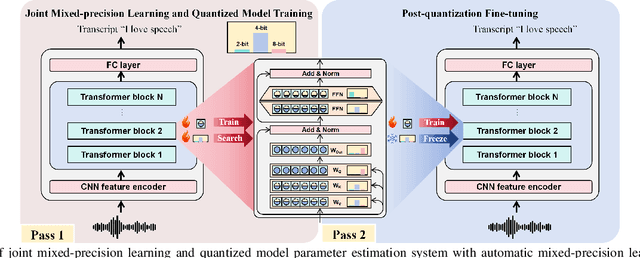
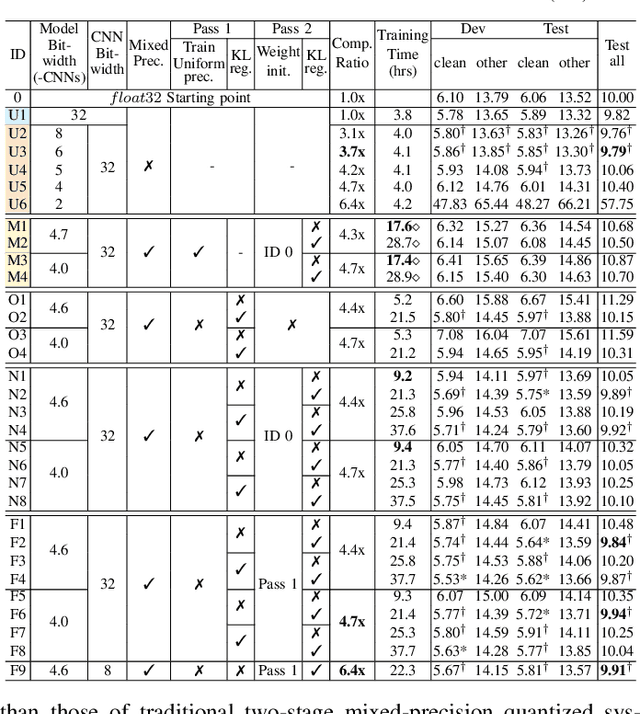
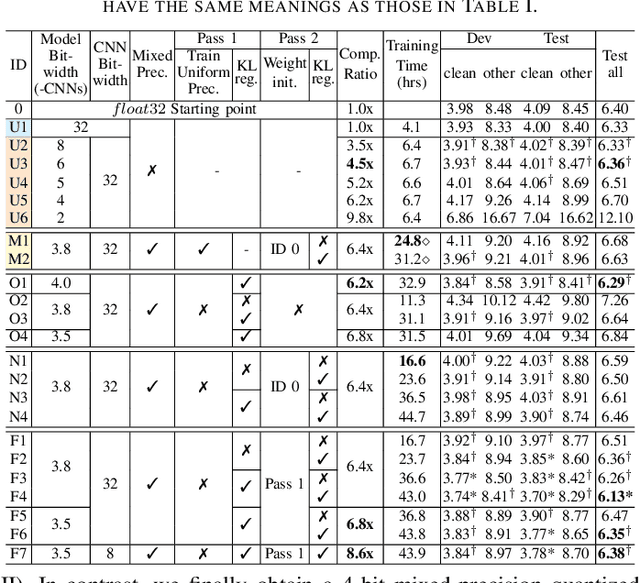
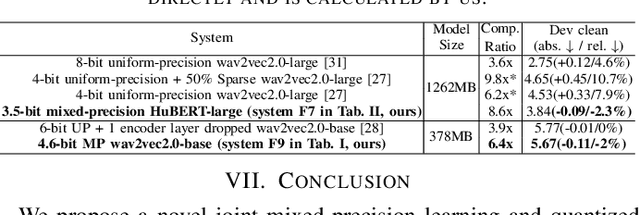
Abstract:This paper presents a novel mixed-precision quantization approach for speech foundation models that tightly integrates mixed-precision learning and quantized model parameter estimation into one single model compression stage. Experiments conducted on LibriSpeech dataset with fine-tuned wav2vec2.0-base and HuBERT-large models suggest the resulting mixed-precision quantized models increased the lossless compression ratio by factors up to 1.7x and 1.9x over the respective uniform-precision and two-stage mixed-precision quantized baselines that perform precision learning and model parameters quantization in separate and disjointed stages, while incurring no statistically word error rate (WER) increase over the 32-bit full-precision models. The system compression time of wav2vec2.0-base and HuBERT-large models is reduced by up to 1.9 and 1.5 times over the two-stage mixed-precision baselines, while both produce lower WERs. The best-performing 3.5-bit mixed-precision quantized HuBERT-large model produces a lossless compression ratio of 8.6x over the 32-bit full-precision system.
Structured Speaker-Deficiency Adaptation of Foundation Models for Dysarthric and Elderly Speech Recognition
Dec 25, 2024Abstract:Data-intensive fine-tuning of speech foundation models (SFMs) to scarce and diverse dysarthric and elderly speech leads to data bias and poor generalization to unseen speakers. This paper proposes novel structured speaker-deficiency adaptation approaches for SSL pre-trained SFMs on such data. Speaker and speech deficiency invariant SFMs were constructed in their supervised adaptive fine-tuning stage to reduce undue bias to training data speakers, and serves as a more neutral and robust starting point for test time unsupervised adaptation. Speech variability attributed to speaker identity and speech impairment severity, or aging induced neurocognitive decline, are modelled using separate adapters that can be combined together to model any seen or unseen speaker. Experiments on the UASpeech dysarthric and DementiaBank Pitt elderly speech corpora suggest structured speaker-deficiency adaptation of HuBERT and Wav2vec2-conformer models consistently outperforms baseline SFMs using either: a) no adapters; b) global adapters shared among all speakers; or c) single attribute adapters modelling speaker or deficiency labels alone by statistically significant WER reductions up to 3.01% and 1.50% absolute (10.86% and 6.94% relative) on the two tasks respectively. The lowest published WER of 19.45% (49.34% on very low intelligibility, 33.17% on unseen words) is obtained on the UASpeech test set of 16 dysarthric speakers.
CR-CTC: Consistency regularization on CTC for improved speech recognition
Oct 07, 2024



Abstract:Connectionist Temporal Classification (CTC) is a widely used method for automatic speech recognition (ASR), renowned for its simplicity and computational efficiency. However, it often falls short in recognition performance compared to transducer or systems combining CTC and attention-based encoder-decoder (CTC/AED). In this work, we propose the Consistency-Regularized CTC (CR-CTC), which enforces consistency between two CTC distributions obtained from different augmented views of the input speech mel-spectrogram. We provide in-depth insights into its essential behaviors from three perspectives: 1) it conducts self-distillation between random pairs of sub-models that process different augmented views; 2) it learns contextual representation through masked prediction for positions within time-masked regions, especially when we increase the amount of time masking; 3) it suppresses the extremely peaky CTC distributions, thereby reducing overfitting and improving the generalization ability. Extensive experiments on LibriSpeech, Aishell-1, and GigaSpeech datasets demonstrate the effectiveness of our CR-CTC, which achieves performance comparable to, or even slightly better than, that of transducer and CTC/AED.
Exploring SSL Discrete Speech Features for Zipformer-based Contextual ASR
Sep 13, 2024



Abstract:Self-supervised learning (SSL) based discrete speech representations are highly compact and domain adaptable. In this paper, SSL discrete speech features extracted from WavLM models are used as additional cross-utterance acoustic context features in Zipformer-Transducer ASR systems. The efficacy of replacing Fbank features with discrete token features for modelling either cross-utterance contexts (from preceding and future segments), or current utterance's internal contexts alone, or both at the same time, are demonstrated thoroughly on the Gigaspeech 1000-hr corpus. The best Zipformer-Transducer system using discrete tokens based cross-utterance context features outperforms the baseline using utterance internal context only with statistically significant word error rate (WER) reductions of 0.32% to 0.41% absolute (2.78% to 3.54% relative) on the dev and test data. The lowest published WER of 11.15% and 11.14% were obtained on the dev and test sets. Our work is open-source and publicly available at https://github.com/open-creator/icefall/tree/master/egs/gigaspeech/Context\_ASR.
Large Language Model Can Transcribe Speech in Multi-Talker Scenarios with Versatile Instructions
Sep 13, 2024



Abstract:Recent advancements in large language models (LLMs) have revolutionized various domains, bringing significant progress and new opportunities. Despite progress in speech-related tasks, LLMs have not been sufficiently explored in multi-talker scenarios. In this work, we present a pioneering effort to investigate the capability of LLMs in transcribing speech in multi-talker environments, following versatile instructions related to multi-talker automatic speech recognition (ASR), target talker ASR, and ASR based on specific talker attributes such as sex, occurrence order, language, and keyword spoken. Our approach utilizes WavLM and Whisper encoder to extract multi-faceted speech representations that are sensitive to speaker characteristics and semantic context. These representations are then fed into an LLM fine-tuned using LoRA, enabling the capabilities for speech comprehension and transcription. Comprehensive experiments reveal the promising performance of our proposed system, MT-LLM, in cocktail party scenarios, highlighting the potential of LLM to handle speech-related tasks based on user instructions in such complex settings.
Homogeneous Speaker Features for On-the-Fly Dysarthric and Elderly Speaker Adaptation
Jul 08, 2024



Abstract:The application of data-intensive automatic speech recognition (ASR) technologies to dysarthric and elderly adult speech is confronted by their mismatch against healthy and nonaged voices, data scarcity and large speaker-level variability. To this end, this paper proposes two novel data-efficient methods to learn homogeneous dysarthric and elderly speaker-level features for rapid, on-the-fly test-time adaptation of DNN/TDNN and Conformer ASR models. These include: 1) speaker-level variance-regularized spectral basis embedding (VR-SBE) features that exploit a special regularization term to enforce homogeneity of speaker features in adaptation; and 2) feature-based learning hidden unit contributions (f-LHUC) transforms that are conditioned on VR-SBE features. Experiments are conducted on four tasks across two languages: the English UASpeech and TORGO dysarthric speech datasets, the English DementiaBank Pitt and Cantonese JCCOCC MoCA elderly speech corpora. The proposed on-the-fly speaker adaptation techniques consistently outperform baseline iVector and xVector adaptation by statistically significant word or character error rate reductions up to 5.32% absolute (18.57% relative) and batch-mode LHUC speaker adaptation by 2.24% absolute (9.20% relative), while operating with real-time factors speeding up to 33.6 times against xVectors during adaptation. The efficacy of the proposed adaptation techniques is demonstrated in a comparison against current ASR technologies including SSL pre-trained systems on UASpeech, where our best system produces a state-of-the-art WER of 23.33%. Analyses show VR-SBE features and f-LHUC transforms are insensitive to speaker-level data quantity in testtime adaptation. T-SNE visualization reveals they have stronger speaker-level homogeneity than baseline iVectors, xVectors and batch-mode LHUC transforms.
Towards Effective and Efficient Non-autoregressive Decoding Using Block-based Attention Mask
Jun 14, 2024
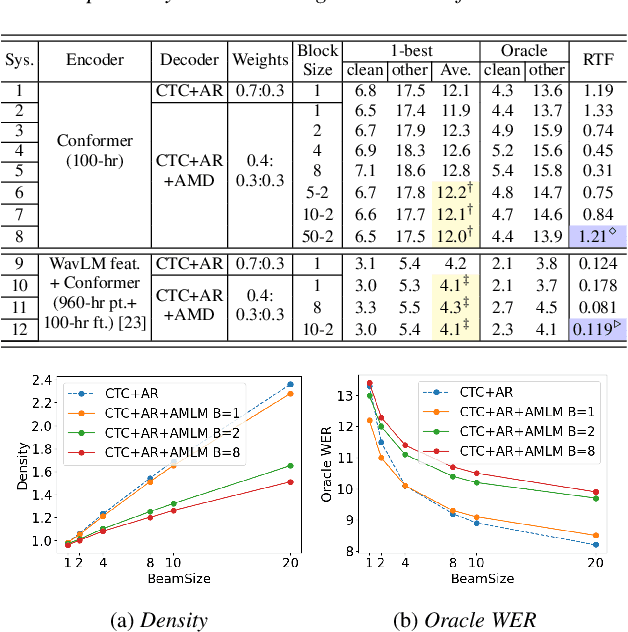

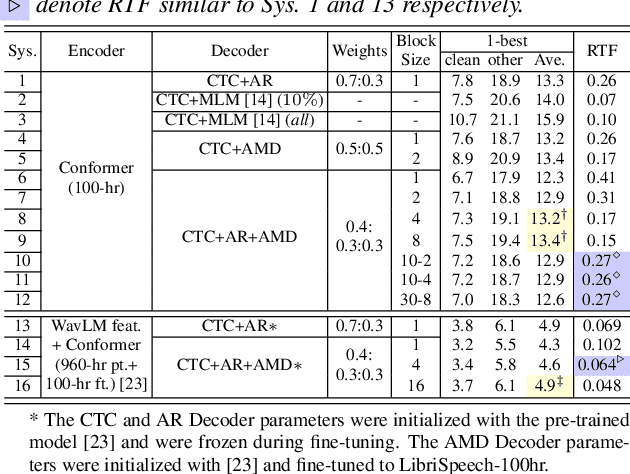
Abstract:This paper proposes a novel non-autoregressive (NAR) block-based Attention Mask Decoder (AMD) that flexibly balances performance-efficiency trade-offs for Conformer ASR systems. AMD performs parallel NAR inference within contiguous blocks of output labels that are concealed using attention masks, while conducting left-to-right AR prediction and history context amalgamation between blocks. A beam search algorithm is designed to leverage a dynamic fusion of CTC, AR Decoder, and AMD probabilities. Experiments on the LibriSpeech-100hr corpus suggest the tripartite Decoder incorporating the AMD module produces a maximum decoding speed-up ratio of 1.73x over the baseline CTC+AR decoding, while incurring no statistically significant word error rate (WER) increase on the test sets. When operating with the same decoding real time factors, statistically significant WER reductions of up to 0.7% and 0.3% absolute (5.3% and 6.1% relative) were obtained over the CTC+AR baseline.
One-pass Multiple Conformer and Foundation Speech Systems Compression and Quantization Using An All-in-one Neural Model
Jun 14, 2024



Abstract:We propose a novel one-pass multiple ASR systems joint compression and quantization approach using an all-in-one neural model. A single compression cycle allows multiple nested systems with varying Encoder depths, widths, and quantization precision settings to be simultaneously constructed without the need to train and store individual target systems separately. Experiments consistently demonstrate the multiple ASR systems compressed in a single all-in-one model produced a word error rate (WER) comparable to, or lower by up to 1.01\% absolute (6.98\% relative) than individually trained systems of equal complexity. A 3.4x overall system compression and training time speed-up was achieved. Maximum model size compression ratios of 12.8x and 3.93x were obtained over the baseline Switchboard-300hr Conformer and LibriSpeech-100hr fine-tuned wav2vec2.0 models, respectively, incurring no statistically significant WER increase.
 Add to Chrome
Add to Chrome Add to Firefox
Add to Firefox Add to Edge
Add to Edge